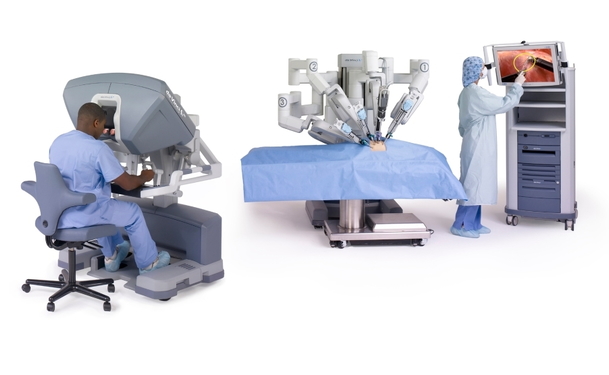Robot-assisted surgery is a method in which a trained surgeon manipulates mechanical arms on a specially designed robot to accomplish the tasks he or she would normally perform by hand. Most robot-assisted surgeries take only two to three hours under general anesthesia, with the time needed depending on the type of surgery and the complexity of the patient’s case.
About Robot-Assisted Surgery
The surgeon begins by making three to six tiny incisions. The location of those incisions depends on the condition and the part of the anatomy being treated. A small tube is inserted into one of the incisions and the abdomen is filled with carbon dioxide to spread the internal organs and improve the surgeon’s view. Next, a long, thin tube with a light source and camera at its tip (endoscope) is inserted through one of the cuts, giving the surgeon a magnified, three-dimensional view of the operating site in real time.
The necessary surgical instruments are attached to the arms of the robot and inserted into the patient through the remaining keyhole incisions. The surgeon operates these robotic arms from a special console in the operating room. The robotic arms can rotate 360 degrees, allowing a surgeon to move the instruments more precisely than is possible in standard laparoscopic surgeries. The robotics can also scale the surgeon’s hand movements; meaning, large motions translate into small instrument movements, and can filter out hand tremors.
Robot-Assisted Procedures
Robotic surgery can be used for a variety of procedures, including:
- Cystectomy: This procedure is used to treat bladder cancer that has moved to the bladder wall. Here, all of the bladder is removed. If a radical cystectomy is performed, nearby lymph nodes, a portion of the urethra, and adjacent organs that contain cancer cells may be removed too. To promote urinary function, either a piece of the small intestine is extracted to make a tube that links the ureters to an opening in the belly, or a portion of the bowel is taken to make a storage pouch that is connected to the pelvis.
- Pyeloplasty: This surgical procedure is used to treat ureteropelvic junction obstruction, which occurs when there is a blockage of the renal pelvis (the point where the ureters and kidneys meet). Here, the blocked portion of the renal pelvis is excised and a channel is created using tissue from the remaining ureter and renal pelvis. By removing the obstruction, the kidneys decompress and urine is allowed to flow freely between the kidneys and the bladder.
- Nephrectomy: A nephrectomy is typically done to treat kidney cancer or to extract a diseased or damaged kidney. The surgeon makes one or more incisions in the abdomen and the kidney is pulled through so that all or part of it can be removed.
- Radical prostatectomy: If a patient presents with prostate cancer, the prostate gland and some of the tissue surrounding it may be completely removed through an incision made in the lower abdomen or between the anus and scrotum.
- Kidney transplant: A new, healthy kidney can be transplanted into the patient's body if he or she has lost a kidney due to cancer or other types of disease.
Robot-assisted surgery can also be used to cut away cancerous tissue from blood vessels, nerves and bodily organs, including the prostate, kidney, bladder, and ureters.
Benefits of Robot-Assisted Surgery
Open surgery involves large incisions and can require several days in the hospital following a procedure, as well as months for recovery. On the other hand, robot-assisted surgeries can significantly decrease the time needed for operations and can allow patients to return to normal activities in as little as two to three weeks. Other benefits include:
- Smaller incisions
- Minimal scarring
- Less blood loss
- Decreased need for blood transfusion
- Less pain and need for pain medication
- Quicker recovery
- Less risk of infection
Risks of Robot-Assisted Surgery
As with any major operation, robot-assisted surgeries involve risks, the most serious of which include heart attack, stroke, and death. In the hands of experienced surgeons, there may be significantly fewer operative and post-operative complications. Still, robotic surgery carries many of the same risks as open or conventional laparoscopic surgeries, including:
- Infection
- Excessive blood loss/need for blood transfusion
- Hernia
- Urinary incontinence
- Deep vein thrombosis
- Recurrence of the original condition
- Erectile dysfunction (when performing a prostatectomy)
- Increased need for future radiation therapy (in cases of cancer)
- Rectal or bowel injury (when performing a prostatectomy)
- Injury to adjacent organs
References:
Finkelstein J., Eckersberger E., Sadri H., et al. (2010). Open versus laparoscopic versus robot-assisted laparoscopic prostatectomy: The European and US Experience. Rev Urol.
Estey, E.P. (2009). Robotic prostatectomy: The new standard of care or a marketing success? Can Urol Assoc J.
Lee, D.I. (2009). Robotic prostatectomy: What have we learned and where are we going?” Yonsei Med J.


